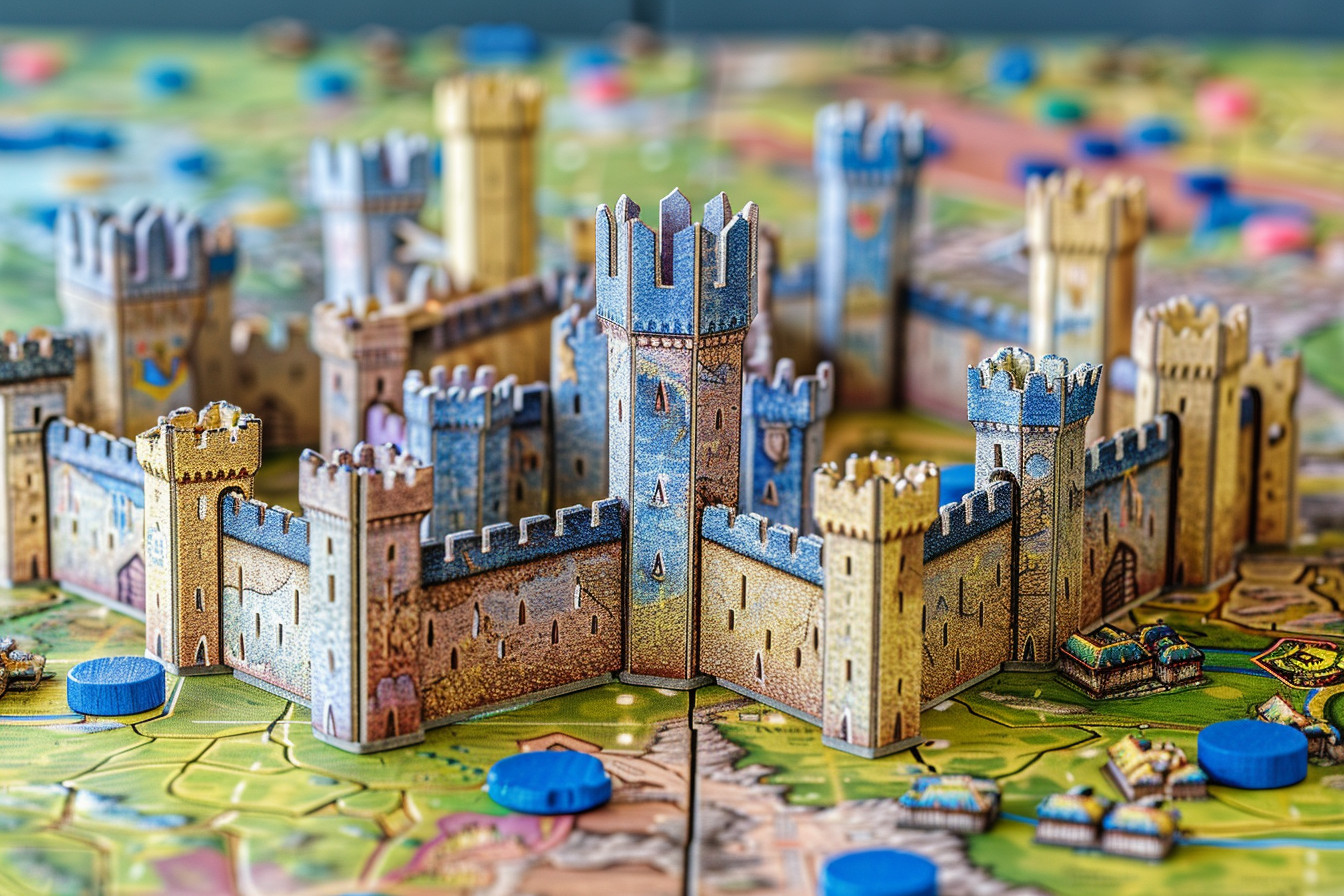My first impression of Ticket to Ride: USA was a wave of excitement. As a lover of strategic games, the prospect of negotiating across the sprawling terrain of America by railroad appealed to me like nothing else. The striking walnut color design of the game board, colorful railway lines with different train cars and endless promise of a fun competitive experience was enough to pique my interest right away.
Ticket to Ride: USA is the original Ticket to Ride created by Alan R. Moon and Days of Wonder. Simple rules combined with deep strategic play mean that Railfans around the world have been captivated from the day it was first released till today. The entire essence of the game lies in building iron routes across North America. Players connect cities for points with their destination tickets and seek to outdo other players to get their score high enough to win victory.
Game Overview
Ticket to Ride: USA is a board game designed for 3-5 players that usually takes about 30 minutes to play. Set in the early 20th century, the game is the story of building railway routes across North America. Each player tries to score more points than his rivals by occupying lines between cities and so on, completing destination tickets that have
Game Board: The board is a map of the USA, beautifully illustrated with major cities connected by a network of potential railway routes. Each route is marked with spaces so that players can lay their own train cars there to claim the route.
Train Cars: Every player gets a set of 45 brightly colored plastic train cars. These are used to claim routes on the map. The train cars are solid and brightly colored, so placing them on the board is a cinch.
Destination Tickets: These cards are central to the game’s strategy. Each one offers two U.S. cities that players must connect by a continuous line of their own train cars. Successful completion of these routes adds good to your score, while failing to do so penalizes you.
Train Cards: These cards come in various colors and are used to claim routes on the board. Players collect and play them in order to match the color and number of spaces on a claimed route.
Scoring Markers: These are used to track the score for each player on the board’s outer edge. Points are awarded for claiming routes, completing destination tickets, and having the longest continuous route at the end of the game.
Gameplay is simple yet requires deep strategy to be successful. It begins with every player receiving a set of train cards and destination tickets. Players may keep any number of tickets they like, but they must hold at least two. Throughout the game, these tickets influence how they will play their cards.
Turn Structure
Draw train cards: The player draws two cards face up in front of him and puts them in a row on his cardholder. He may take these from the five face-up card or draw a new one off topmost pile. If any player takes a face-up locomotive (it is wild, like Carl) then he can only draw one card instead of two. But this is a crucial activity because it allows a player to collect the sets needed in order to claim routes.
Claiming a Route: To claim a route on the board, a player needs to lay a set of train cards that match the colour and number of spaces on that route. Next, the player physically places his train cars upon the route, scores bonus points depending upon how long it is, and discards train cards which may have been used.
Draw Destination Tickets: A player may draw three new destination tickets from the draw pile. He must keep at least one but may keep two or all three if he wishes. New tickets can be risky business, as uncompleted tickets will be penalized at the end of the game.
Claiming Routes and Scoring Points
Claiming routes is the main way players score points in the game. The length of the route determines the number of points scored. Here is the scoring table for route lengths:
- 1 train car: 1 point
- 2 train cars: 2 points
- 3 train cars: 4 points
- 4 train cars: 7 points
- 5 train cars: 10 points
- 6 train cars: 15 points
Longer routes yield more points but require more cards to claim. Players should decide strategically when to concentrate on shorter routes for quick points and when to accumulate cards for the valuable longer routes. Completion of Destination Tickets
At the end of the game, players show their destination tickets and see if they have successfully connected the two cities mentioned on each ticket. Completed tickets score the points indicated on the card, while uncompleted tickets deduct those points from your total score. Managing and completing destination tickets successfully is crucial to winning the game. Since they can provide significant points, not to complete a ticket is to lose out big time.
Continuous Route Bonus
The continuous route bonus is a unique feature of Ticket to Ride: USA. A bonus of 10 points is awarded to whichever player has the longest continuous path of train cars. In this way, it forces people to think about how to join their routes together on the map, turning a number of long single lines into one sprawling network, which brings another level of strategy to the game.
Some Strategy Tips
- Balance Long and Short Routes: While long routes offer more points, short ones can be useful to connect cities quickly and pick up destination tickets. A mix of both is crucial for success.
- Manage Your Train Cards: Efficiently managing your supply of train cards is vital. Decide carefully when to collect more cards, when to lay track on existing routes and when to risk using joker cards.
- Plan Ahead: Monitor your destination tickets and plan your routes ahead of time. Adapt your strategy in the course of the game based on which routes your competitors secure.
As an extra twist, the game features the Continuous Route Bonus. By putting together a long string of connected routes, you can win a special prize at the end of the game. Plan a route that takes full advantage of this opportunity.
In the end, Ticket to Ride: USA offers a vibrant gameplay experience combining strategy, competition and a cushion of luck. Its unique characteristics and strategic depth set it up as an outstanding contestant in the board game world providing endless diversion and challenge for everyone who plays.
Pros and Cons
- Pros
Engaging and Strategic Gameplay
This is a strategic game that involves a lot of suspense and should keep players riveted throughout each round. In addition to figuring out your tracks of travel, you are also able to manage a hand full of train cards and make sharp strategic decisions intimately which between the routes in given sections one particularly trains for! The game play is constantly layered with contrasting short-term gains set against the long-run goals for added complexity.
Beautiful Components and Design
The components of Ticket to Ride: USA are both functional and beautiful in their design. The game board is lavishly illustrated, giving a detailed map of the United States with routes and cities clearly marked. Train cards and destination tickets are well designed too, with lively colors and clear legible print. The plastic locomotives are robust and come in many colors to augment game’s visual appeal.
For The Whole Family
Ticket to ride: USA belongs to an ever-widening circle of board games that offer pleasure for people of all ages. Its rules are simple enough to be grasped by very young children, while the depth of strategy involved guarantees enjoyable play for adults as well. The game’s competitive yet good-natured spirit promotes interaction between people at every stage of life.
Educational Value
The game certainly has educational value. If not revealeved in words, the basics of geography of the United States might naturally come through here just from playing the game. And it also teaches one about planning, resource management and strategic thinking. The historical background of railroads in America provides another extra advantage.
- Cons
Potential for Downtime
One of the major drawbacks of Ticket to Ride: USA is that it can come to an impulsive halt. This downtime, especially in games with the full complement of players, is something that cannot but break up the rhythm and (in some cases) make players lose their interest in the game altogether. Getting players to plan their moves in advance can help alleviate some of this problem.
Luck of the Draw
Though strategy is a significant part of the game, there is also an element of luck, particularly in drawing train cards and tickets to destinations. Sometimes, players may struggle to draw the cards they require–a situation frustrating for them. Similarly, if you draw hard tickets to destinations, scoring points gets that much harder. It’s this uncertainty which makes the game exciting and unpredictable, however.
Complexity for New Players
While Ticket to Ride: USA is generally easy to learn, new players may be troubled by some parts of the game. With the cards locomotives and a continuous route bonus involved many people find this section to be more than they can handle at first try. The extra rules about either of these features can leave newcomers to the game with an overwhelming sense. But after just a little practice under some leadership from players who know what they’re doing, people who have never played before start to pick things up quickly.
Space Requirements
The game board is very large and during setup requires quite a bit of table space. This can be quite a challenge for players with limited space, especially when the maximum number of players are involved. Making sure you have a decent game area can give your whole experience a lift and also save you from bad experiences of operation logistics.
In any case, we have far more pros than cons with Ticket to Ride: USA. The game’s dynamic and strategic playing level, high replayability and beautiful components make it a star in board games for pleasure. The degree of accessibility, and at the same time that it educates those who play with it further enhance its appeal. It is a game that any board game collection will be better for having is in it.
Is It Worth Buying?
Reflecting on my experiences with Ticket to Ride: USA, I find it to be a delightful and enthralling game to own. The game’s combining of strategy, competition and just a touch of luck together provide excitement every time you play. Ultimately, whether it is worth buying or not depends on what sort of game you like to play.
If you enjoy games that require skillful planning and thinking, Ticket to Ride: USA is a good choice. In it you have to manage resources carefully and plan routes well, for though opponents change their tactics according to yours,bilocowith its mechanics The continuous route bonus and using locomotive cards strategically provide an added layer of depth that will keep strategy fans wanting more.
Final Thought
On Ticket to Ride: USA is a rich, well-played board game which combines strategy and luck. There is plenty of scope for challenge and a great deal of fun. It is good for growing both numbers of players, and the number who play regularly. Therefore, for both serious and casual gamers alike, this game on register as a must have! Novice or expert board game player, a game of Ticket to Ride: USA will mean many hours of fun and pleasure.
The game’s availability to wider ranks of players also makes it an esteemed board game: it costs very little to play and is easily reached by all. If you’re into strategic planning, friendly competition and geography/history learning, then Ticket to Ride: USA is certainly worth a look. This process guarantees yourself and friends or family an exciting, satisfying time together which will prove rewarding.








